The Sax Zim Bog is “actually about 300 square miles of not only bog, but aspen uplands, rivers, lakes, meadows, farms and even a couple towns! It is not just a giant bog, but rather a “magic mix” of habitats that boreal birds love” (saxzim.org).
The bog is located about an 1 hour north of Duluth, MN on Highway 53.
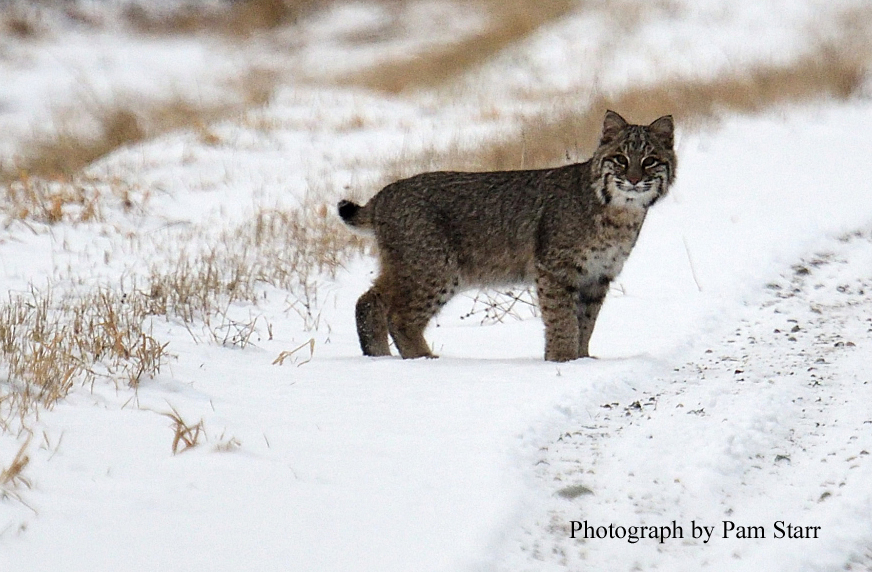
Bobcat
Photo by Pam Starr
“We were driving and saw two animals in the road. We weren’t sure what they were, maybe wolves, but they looked too small. Perhaps pine martens, but these animals were larger than a marten. The two animals ran across the road and into the trees. Then all of a sudden, from the left side of the road, out popped this bobcat. It was still pretty far away, but stayed long enough for a few snapshots.” Pam Starr
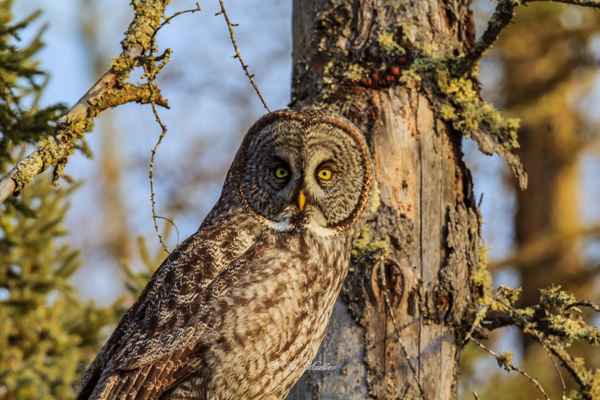
Great Gray Owl
Vivian Mueller
Great Grey Owls are residents of the Sax Zim bog (In fact, there is a nest that is visible from Admiral Rd). Bogs and swampy boreal forests are ideal habitat for Great Greys. They hunt mice at night and in the dusk and at dawn and will eat up to 7 mice a day.
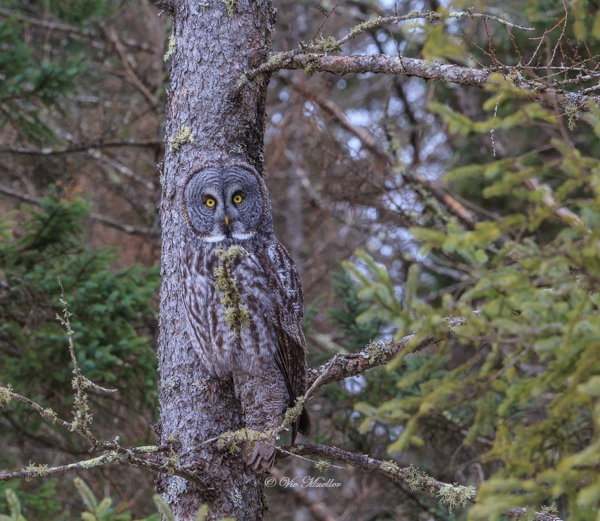
Great Gray Owl
Vivian Mueller
Great Grays are very hard to spot if they’re sitting among the trees. As you can see, they are very well camouflaged.
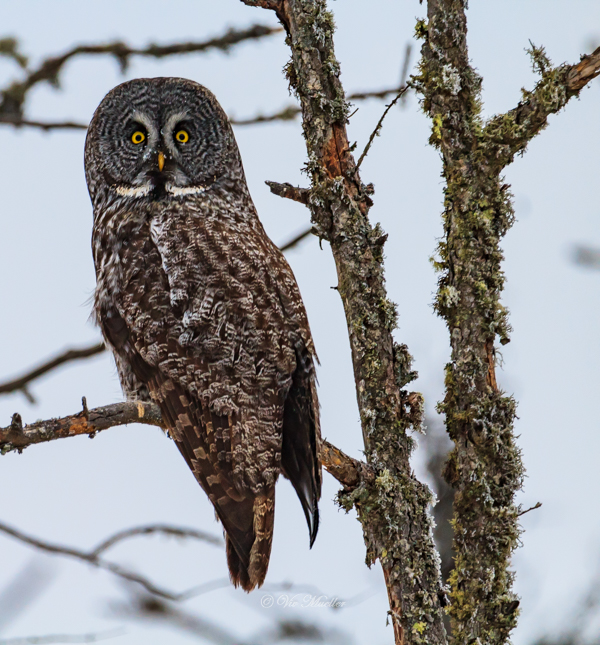
Great Gray Owl
Vivian Mueller
The Great Grey is the largest owl in North America, with a wing span of 60 inches. However, they only weigh about 2 lbs. The facial disk of the great gray acts as a sound receptor.The feathers in the facial disk direct the sound to its ears. It can hear even the slightest movement of a mouse under the snow or in the leaves.
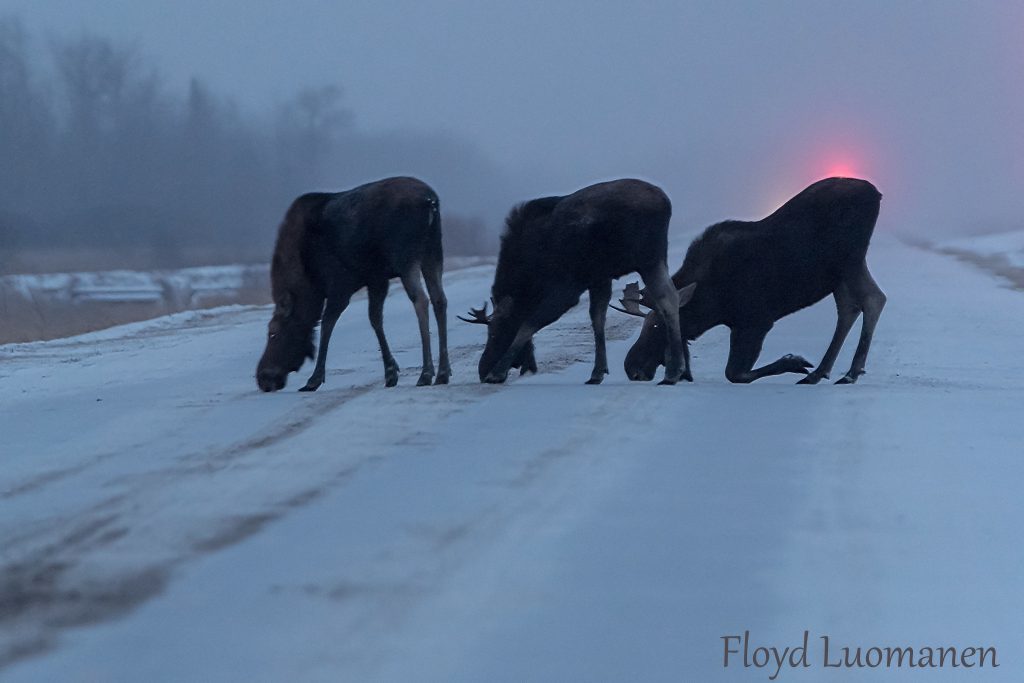
The red light behind the moose is an approaching train.
Photo by Floyd Luomanen
It was 7:20 in the morning and still dark. In the distance, I saw what appeared to be cars silhouetted from the headlight of an oncoming train. As I got closer, these 3 huge moose were blocking the entire road. I pulled over probably 200 feet short of them and tried to take some pictures. One knelt to the ground and my first thought was it might be injured. Then all 3 started licking the road, probably because of the salt. The craziest thing is they all bolted across the railroad tracks not 3 seconds in front of that train. I thought for sure I was going to see at least one of them get hit. Thankfully they all made it across.
Floyd Luomanen
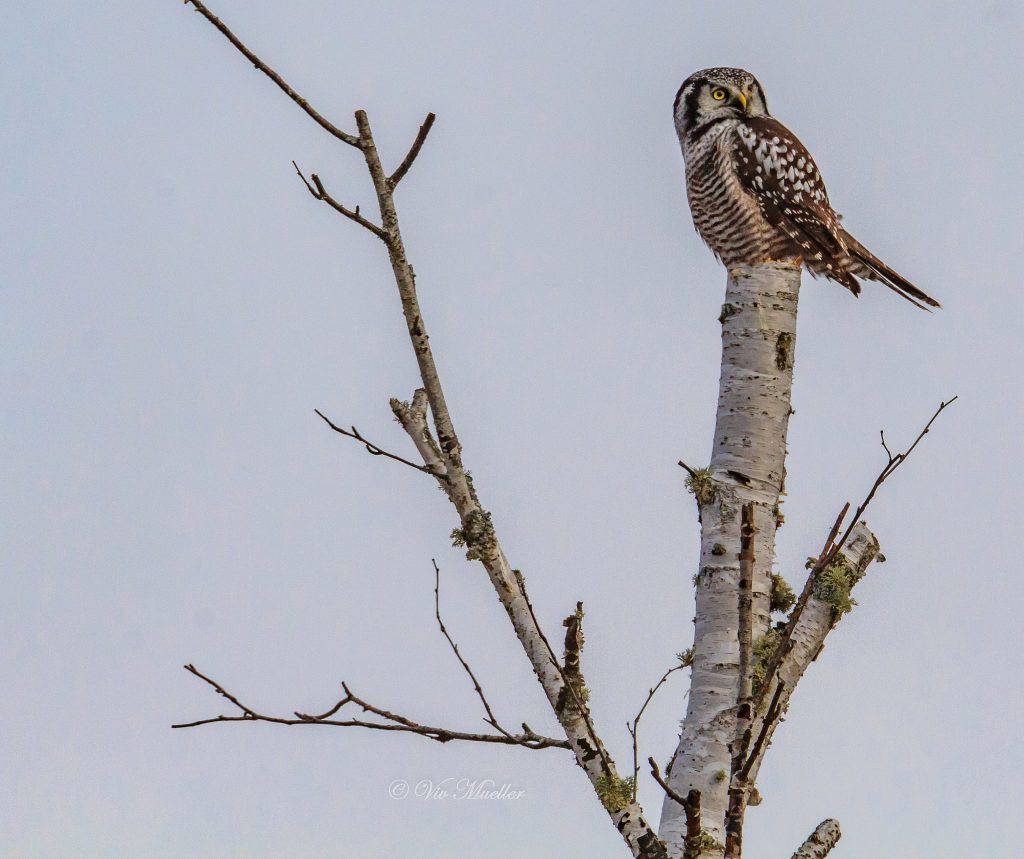
Northern Hawk Owl
Vivian Mueller
The Northern Hawk Owl is a resident of Sax Zim. They are non migratory owls who hunts during the day and usually sits high on top of the trees. This smaller owl does not have typical owl traits. They do not have silent flight like most owls. They do not have a keen sense of hearing that would allow them to locate prey at night.
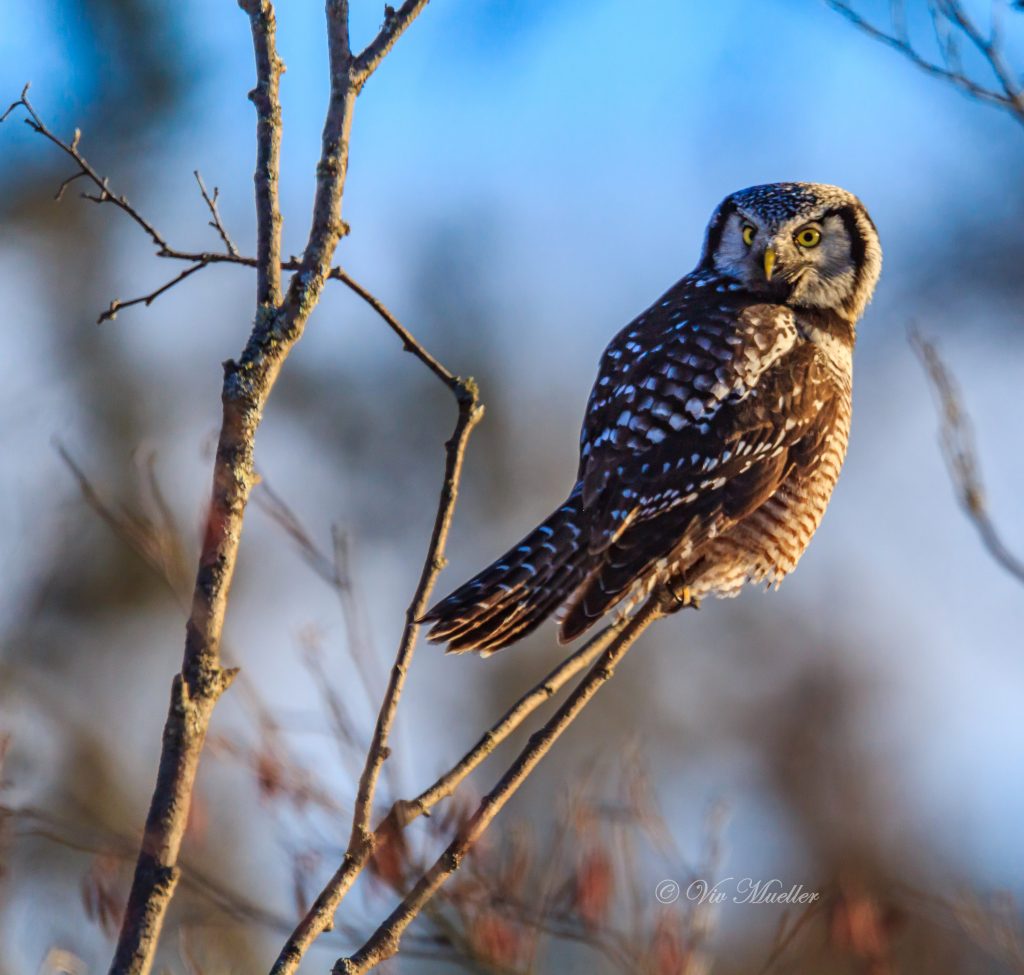
Northern Hawk Owl
Vivian Mueller
Hawk Owls have excellent eye sight. Researchers could routinely attract hawk owls perched a mile away using a fake mouse attached to fishing line. Even if a hawk owl is not hungry, it will continue to hunt and then stash its prey for later when food is scarce.
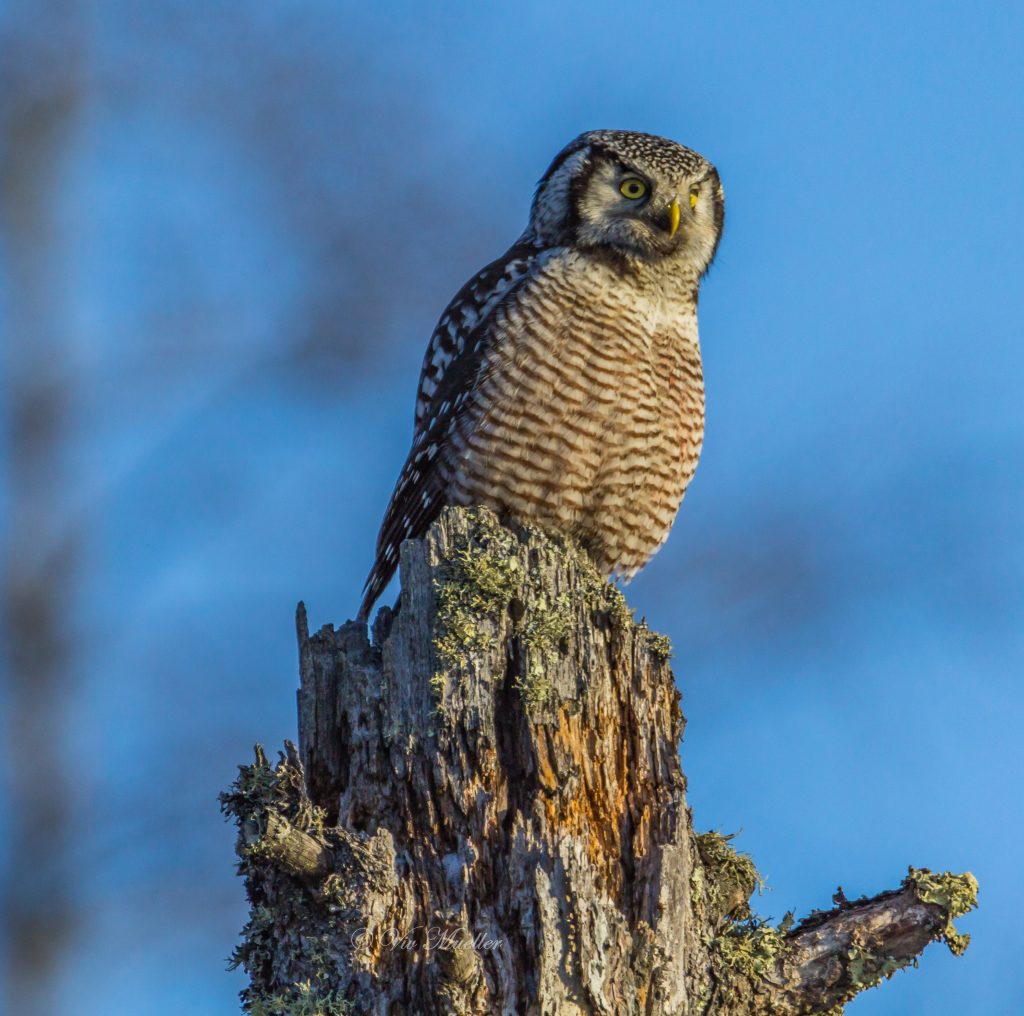
Northern Hawk Owl
Vivian Mueller
Researchers have observed that the Northern Hawk Owl diet varies as prey populations fluctuate. Their primary food is voles (meadow mice). However, if the vole population was down, hawk owls would kill squirrels and young snowshoe hares. Researchers even observed them killing adult snowshoe hares (possibly 4 times heavier than a Hawk Owl).
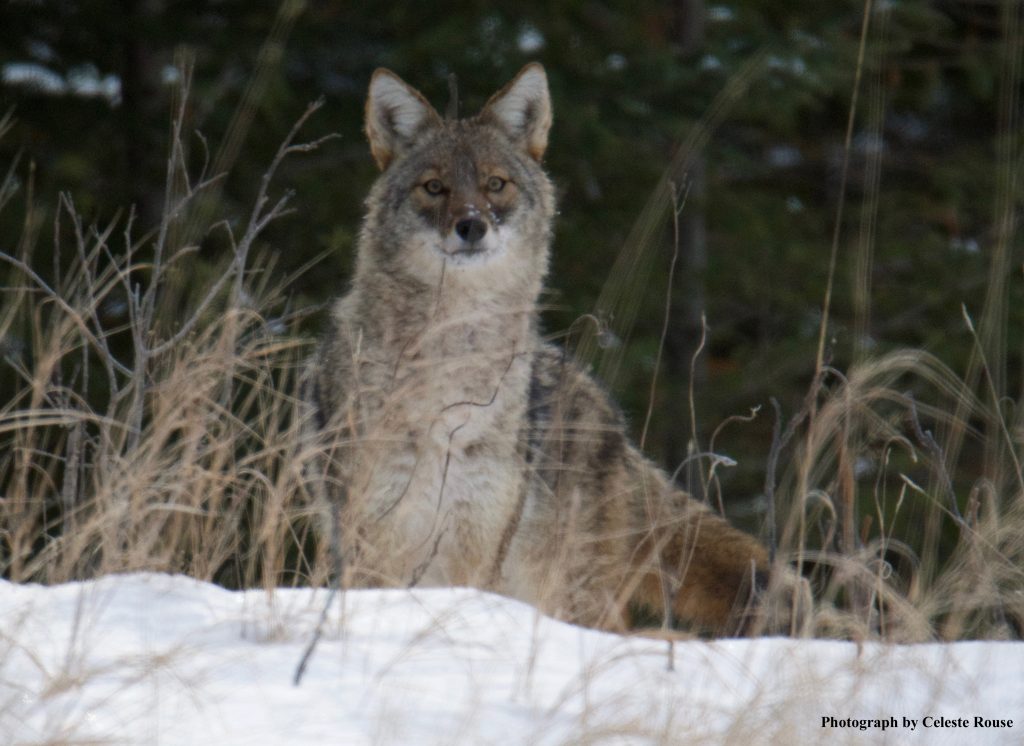
Coyote
Photograph by Celeste Rouse
“I drove around a corner and this beautiful Coyote was standing nearly in the middle of the road. I first shot through my window thinking he was going to flee but he did not. So I got out and shot in the crack of the door. He stayed for about 30 seconds, went to the right and then came back to the same spot in the road and stared in my direction. It was like he wanted something on the other side of the road and maybe I interrupted his plan. He finally dashed off the road but gave me a few more seconds of shooting while on the side. I was exhilarated to see him as I never expected to run across anything at the Bog except birds. I made sure to put my camera down for a moment to just admire him. I have seen coyotes from a distance but never up this close or for this long. That moment lasted me all day long. So exciting!”
Celeste Rouse
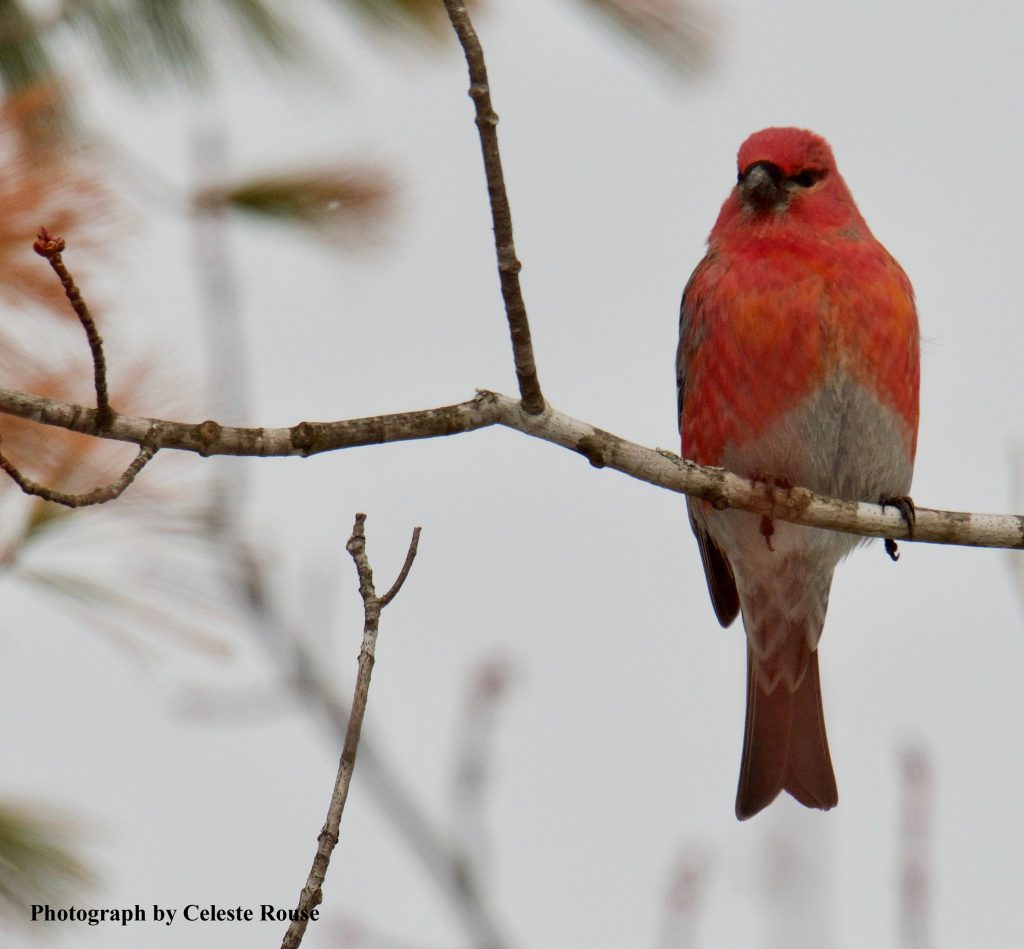
Pine Grosbeak (male)
photograph by Celeste Rouse
Many neighbors of the Sax Zim Bog have winter feeding stations set up for visiting birdwatchers. One of the favorite stops is at Loretta’s.
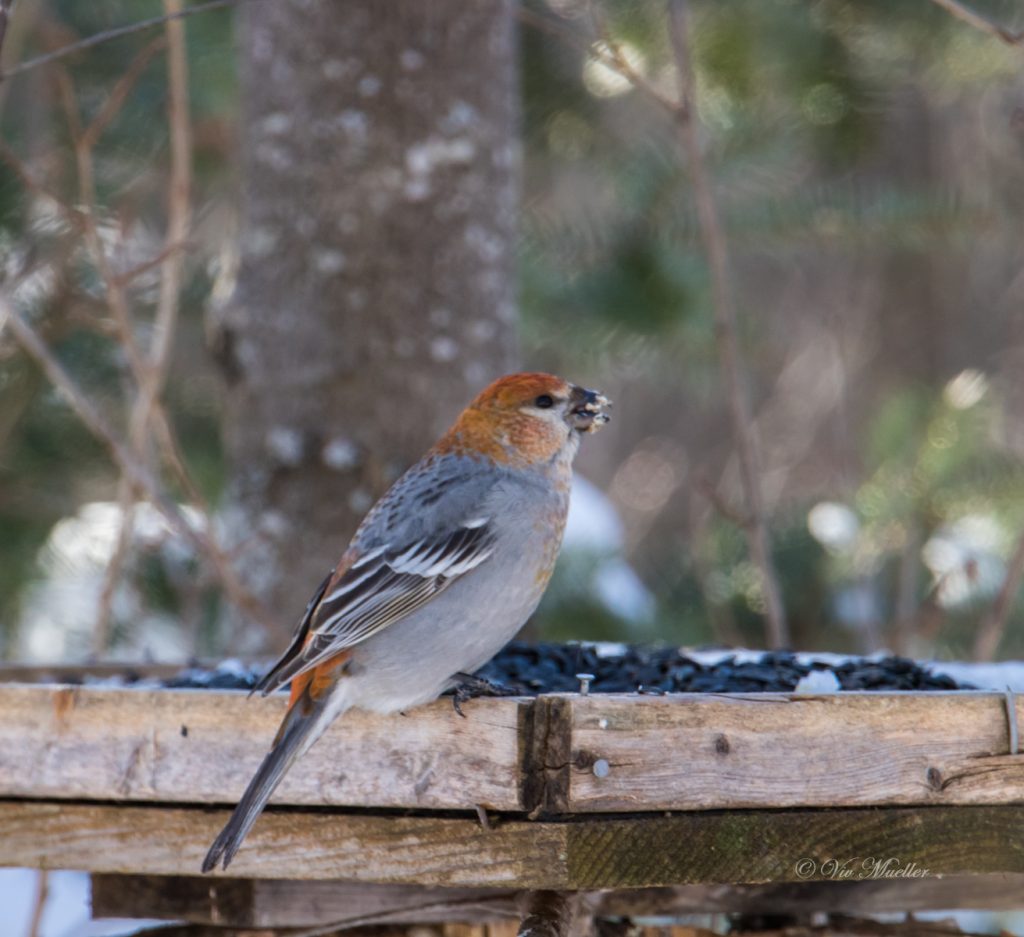
Pine Grosbeak (female) Vivian Mueller
Pine Grosbeaks migrate south from northern Canada to spend the winter at Sax Zim.
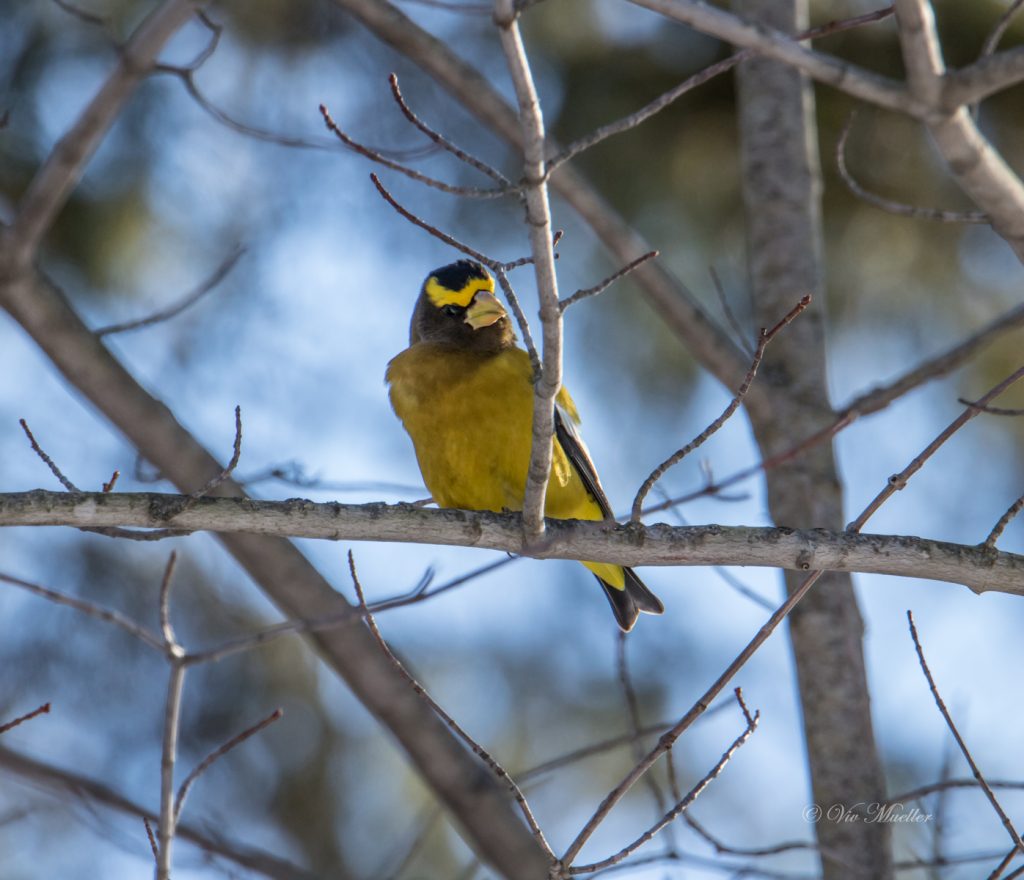
Evening Grosbeak
Vivian Mueller
They are named “grosbeak” for their thick beak which it used to break seeds. One of the oldest observation records of Evening Grosbeak is from 1825, when an Ojibwa boy shot one and called it “Paushkundamo”, an Ojibwa word meaning “berry-breaker.” One observer watching an Evening Grosbeak eating wild cherries could hear the “pop” of a breaking pit 100 feet away!
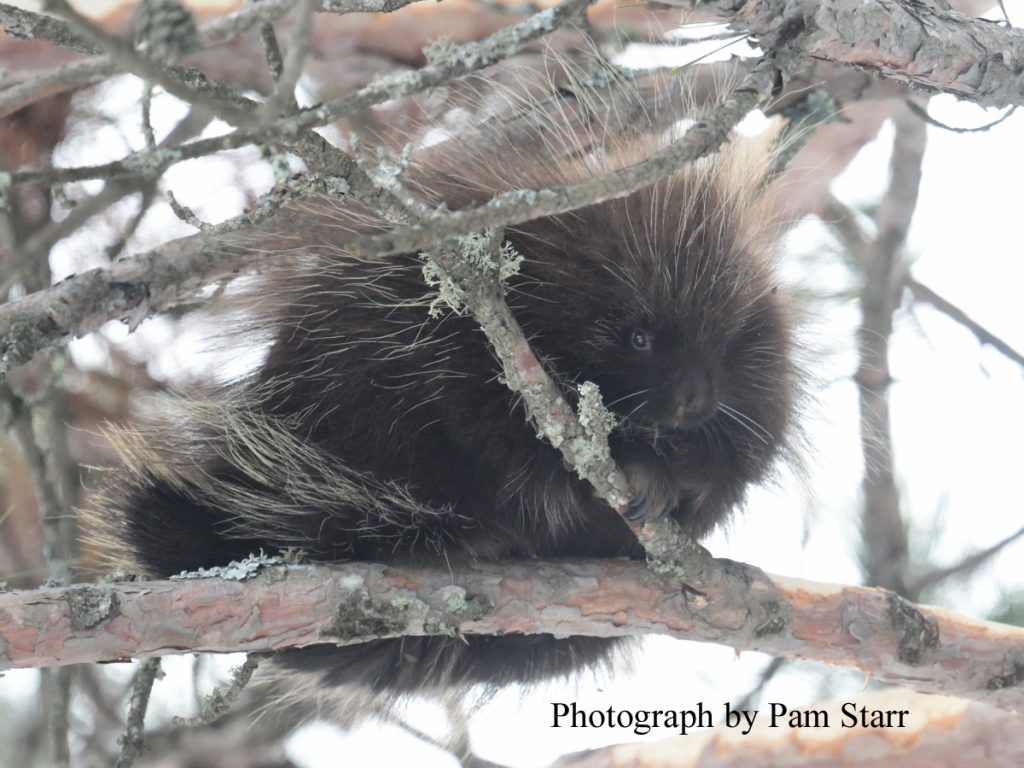
Porcupine
photo by Pam Starr
The porcupine was in a tree on McDavitt road. It’s little buddy was walking around at the base of the tree. I really wanted a picture of the porcupine on the ground but it was camera shy. Pam Starr
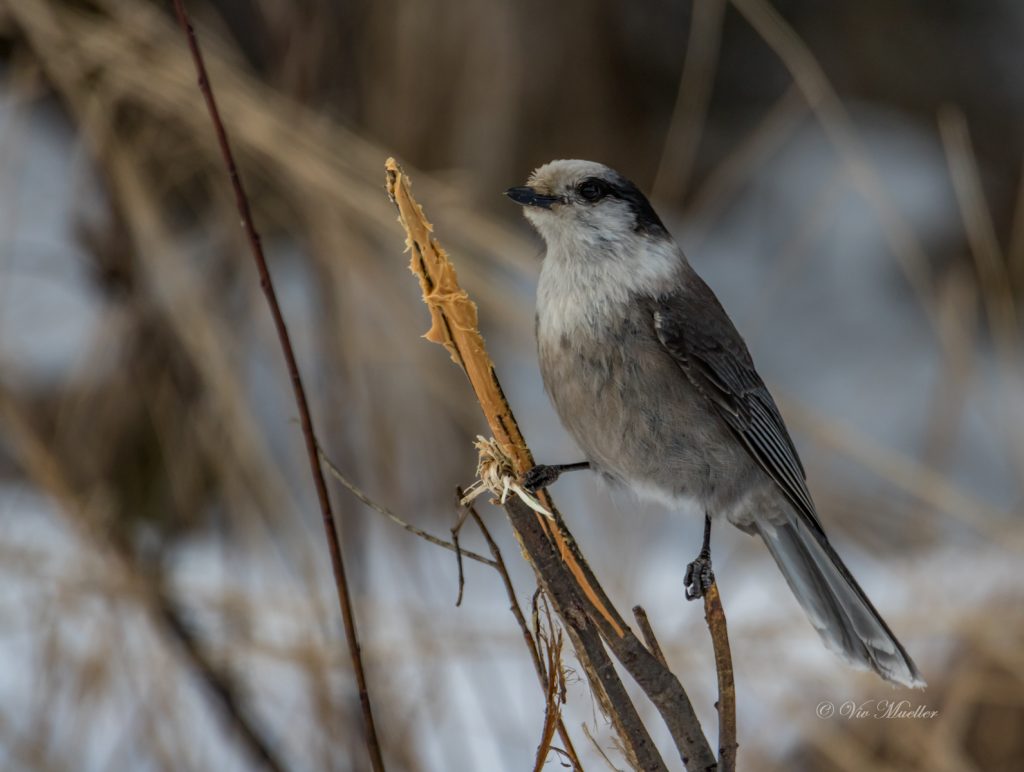
Gray Jay
Vivian Mueller
Gray jays are year round residents of the Sax Zim Bog. They are very curious and may take a peanut from your hand. Gray Jays are also called “whiskey jacks”. The name was taken from “Wiskedijak” an Algonquian word referring to a “mischievous spirit who likes to play tricks on people.”
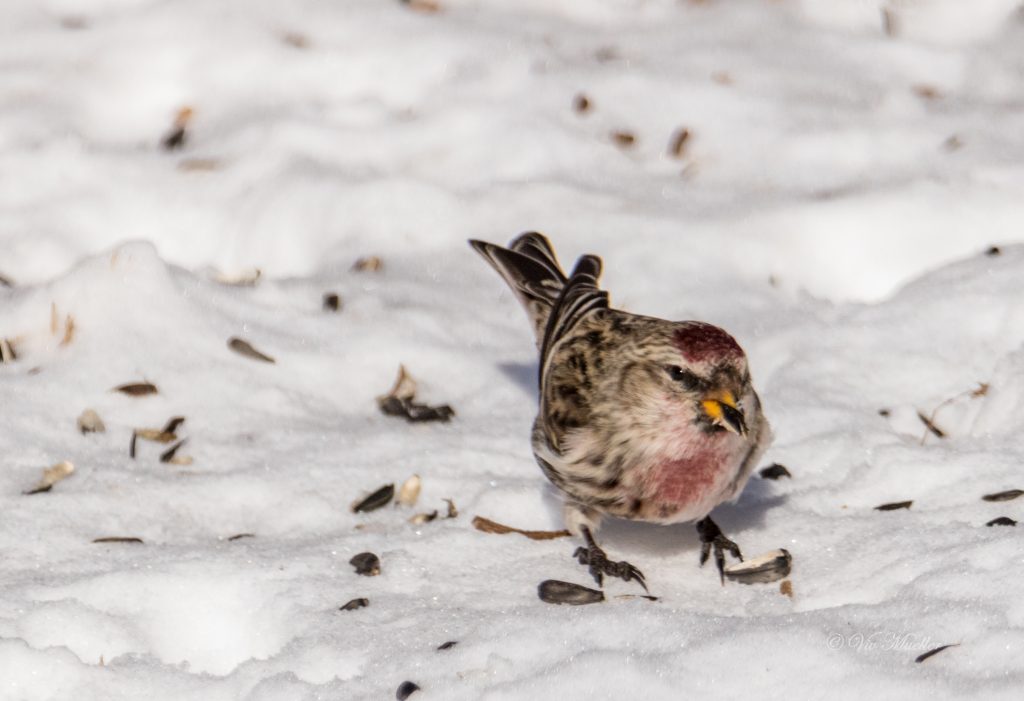
Redpoll
Vivian Mueller
Redpolls breed in Northern Alaska and Canada, migrate down for the winter months when food is scarce.
Credits
- Thanks to Vivian Mueller for generously sharing her photos. To see more of her work go to: www.facebook.com/VivM.Mueller/?ref=bookmarksText
- Floyd Luomanen – Moose photo and text
- Celeste Rouse – Coyote and Pine Grosbeak photo/text and editing support
Pam Starr – Bobcat and porcupine photo and text - References
1. Sax Zim Bog Blog (http://saxzim.org)
2. Northern Hawk Owl www.naturalhistorymag.com/htmlsite/master.html?http://www.naturalhistorymag.com/htmlsite/0603/0603_feature2.html
3. Cornell Lab of Ornithology www.allaboutbirds.org
4. Gray Jay – http://www.hww.ca/en/wildlife/birds/gray-jay.html




Beautiful camera work.
Thanks, bob b
very VERY nice selection!!! <3 Viv
Beautiful and moving!
What fabulous photos and the stories that go with. We are all blessed to have this bog and all that goes with it.
i never knew the old home had so much beauty!!! i thought it was just a swampy bog! Thank you for all the wonderful pictures and braving freezing temps to bring these pictures to us!!!
wonderful pics, thank you!
Keep em coming!!bb
What absolutely fantastic photos! A great sampling of the bog.